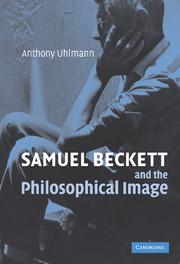Book contents
- Frontmatter
- Contents
- Acknowledgements
- Introduction
- 1 Representation and presentation: Deleuze, Bergson, Peirce and ‘the image’
- 2 Beckett's aesthetic writings and ‘the image’
- 3 Relation and nonrelation
- 4 The philosophical imaginary
- 5 Cogito nescio
- 6 Beckett, Berkeley, Bergson, Film: the intuition image
- 7 The Ancient Stoics and the ontological image
- Conclusion
- Notes
- Works cited
- Index
1 - Representation and presentation: Deleuze, Bergson, Peirce and ‘the image’
Published online by Cambridge University Press: 22 September 2009
- Frontmatter
- Contents
- Acknowledgements
- Introduction
- 1 Representation and presentation: Deleuze, Bergson, Peirce and ‘the image’
- 2 Beckett's aesthetic writings and ‘the image’
- 3 Relation and nonrelation
- 4 The philosophical imaginary
- 5 Cogito nescio
- 6 Beckett, Berkeley, Bergson, Film: the intuition image
- 7 The Ancient Stoics and the ontological image
- Conclusion
- Notes
- Works cited
- Index
Summary
images can never be anything but things, and thought is a movement.
‘IT'S DONE I'VE DONE THE IMAGE’
In Gilles Deleuze: An Apprenticeship in Philosophy, Michael Hardt describes how Deleuze develops themes which have a long history in the Western philosophical tradition, but which have ‘remained suppressed and dormant’. Hardt places Spinoza, Nietzsche and Bergson within a minor tradition which Deleuze develops:
we cannot read Deleuze's work as thought ‘outside’ or ‘beyond’ the philosophical tradition, or even as an effective line of flight from that block; rather we must see it as the affirmation of a (discontinuous, but coherent) line of thought that has remained suppressed and dormant, but nonetheless deeply embedded within that same tradition.
One might apply Hardt's idea to an understanding of the image that has emerged at various times within the Western philosophical tradition, and that has been both suggested by and answered by certain kinds of artistic practice within the Western aesthetic tradition. At times this idea has emerged with clarity and force, and at times the insights it claims to reveal have been surrounded, taunted, ridiculed.
This idea considers that the apprehension of the image (which emerges from the real and is impressed upon our senses like a ‘signet ring in wax’) is fundamental both to our understanding of what the world is and to how we know that world.
- Type
- Chapter
- Information
- Samuel Beckett and the Philosophical Image , pp. 5 - 23Publisher: Cambridge University PressPrint publication year: 2006

